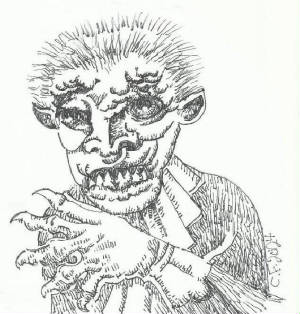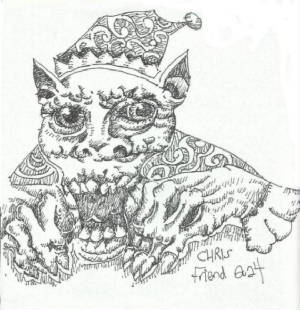|
Autumn, 2024—Chris Friend

|
| Art by Chris Friend © 2024 |
In much of my
research into Halloween folklore one of the most bizarre and truly fascinating
has to be the Legend of Shoney. Almost like something conceived by the
legendary writer of horror fiction, HP Lovecraft, this is a legend of offerings
made on Halloween night to a very ancient deity of the sea. I just loved it and
felt it just perfect for this, the spookiest of holidays.
In ancient Scotland
it was believed that there is a god who haunts the seas especially off the Isle
of Lewis, in the Outer Hebrides. Known as Shoney, this being was thought by
some to be connected to the fairy race known as Kelpies. The Kelpie often
appear in the form of a water horse, and some hold that the beastie in Loch
Ness as being a Kelpie. The name Shoney may be related to the Norse Goddess
Sjofn.
In the old days the
people of the Isle of Lewis were so devout in their belief in Shoney that in
the weeks before Halloween they would carry handfuls of malt into the Church of
St. Mulray. The malt would be processed into ale. On the night of All Hallows
Eve, a man would travel out into the sea with a cup of ale and offer it to the
sea. In ancient Gaelic he would chant "Shoney, I give you this cup of ale
hoping that you will be so kind as to give us plenty of sea-ware for enriching
our ground the ensuing year." The sea-ware in question was sea-weed which
was used as we use manure in our gardens.
Usually the church
was alight with candles and after the offering, the candles were
extinguished and the people at
this strange Halloween gathering would get drunk and dance to honor the old sea-beast/god
known as Shoney.
Neither Lovecraft
nor Poe could have come up with anything this groovy. This is one of my
favorite Halloween legends. Another great Halloween story is Washington
Irving's The German Student. We all know about Irving's wonderful legend
of Sleepy Hollow, the great quintessential Halloween tale, but here's a good
one as well. I can't say too much or it will give away the story. Honest. Have
a really great Halloween.

|
| Art by Chris Friend © 2024 |
Since articles on vampires
are the easiest for me, I decided to do my
usual one on the undead. As most of us know, garlic is a popular herb to ward
off vampires and the evil eye in general. The belief seems to have its origins
in ancient China, but the Egyptians were the first to notice garlic’s healing
properties. It is more likely that people wore garlic when disinterring the
grave of a suspected vampire to ward off the nasty stench of decay. In China
and Malaysia garlic is rubbed on top of the heads of children to ward off the
attack of vampires, in the Philippines garlic is rubbed on armpits to discourage
vampire assault. In Slavic countries where
belief is still strong in the undead, garlic is hung in doorways and windows to
keep the evil dead out. In Rumania on the Eve of St. Andrew's feast (November
30th) when vampires were believed to be most active, garlic was rubbed on door
frames and windowsills. Garlic was even rubbed on cattle to ward off vampire
attack even to keep vampires, witches, and fairies from draining the cattle
dry. Sometimes the corpse of a suspected vampire had garlic stuffed in their
mouths. This happens to Dracula's victim Lucy in Bram Stoker's horror classic.
The vampire seems to be unable to cross any threshold that is smeared with
garlic. I have heard of the practice of burning garlic, used in Cuba by
followers of the Afro Cuban faith of Santeria. One of the more
bizarre folklores concerning vampires can attributed to the gypsies. It was
said that to steal the sock or stocking from a vampire will trigger the
obsessive-compulsive nature of the undead. The vampire will rise and find its
sock missing and be forced to search everywhere for it. So driven to find it
that the vampire might travel out into running water which is dangerous for the
undead. If the undead dares to go out into the running water, such as a river,
it will drown. As with most superstitions there are some contradictory beliefs
in which vampires may lurk in water, notably lore, on the Greek Island of
Santorini suspected vampires were often buried there to keep them from preying
on the living. There is even a saying "taking vampires to Santorini".
The island seems to have such preservative soil that any suspected vampire buried
there will often be very well preserved to the local superstition. Needless to
say, the inhabitants of the island are experts on vampire folklore. And
so it goes.
Chris
Friend, mars_art_13@yahoo.com,
of
Parkersberg, W.Va , who wrote BP #85’s poem, “Demons Play Flutes”; BP # 84’s
poems, “The Sentinel” and “Psalm of Mithra”; the BP #81 poem set, “Angel of the
Bereft,” Beauty’s Sleep,” & “Dark Trinity”; the BP #80 poem, “The Temple of
Colors”; BP #79 poems, “The Marquis” and “My Bloody Valentine”; the BP #78
poem, “The Old Yule Goat”; BP #77’s 4-poem set: “At 50,” “Owls,” “Vintage
Halloween,” & “Xmas in the Doll Asylum”; BP #76’s 4-poem set: “Hag Fairy
Communion,” “Love’s Sepulcher,” “Night Wanderer,” & “St. Andrew’s Feast”;
2
poems for BP #75, “Angel of the Pagan Dead” and “Churchyard Watcher”; BP #72’s
2-poem set, “Ed Gein” & “Sour Puss”; and the 2008 poem “All Hallows’ Eve”,
writes and illustrates our “MARS News” column. He did a cover for Black Petals back
in 2000 for the fall issue, and has been around ever since. BP keeps up two
websites for him and prints his column in the issue quarterly. Chris has a
gallery at http://chris.michaelherring.net/
and was featured artist in Kurt Newton’s Ultimate
PerVersities (Naked Snake) [Jan. 2011].
|

